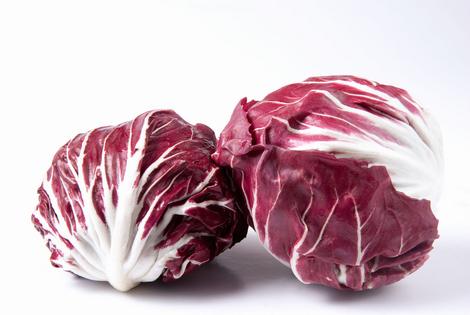ENVIRONMENTAL NUTRITION: Radicchio ranks high in antioxidants
Radicchio is appreciated today for its culinary properties, but its first role was medicinal, lauded by Roman philosopher Pliny the Elder as a blood purifier and aid for insomnia in his encyclopedic "Naturalis Historia." Though modern cultivation of radicchio began in 15th century Italy, it wasn't until the late 1800s that the intensely red color was engineered by growing radicchio in a dark place in order to stop the production of the green compound, chlorophyll, thus enabling the red to dominate.
A member of the chicory family, along with endive, escarole and dandelions, radicchio (Cichorium intybus) is sometimes called Italian chicory, red chicory and red endive. There are several varieties of radicchio, each named after its Italian region of origin. They have similarly firm leaves and a bittersweet flavor but vary significantly in appearance, from red-globed Chiogga, to elongated Treviso and flower-like Tardivo and Castelfranco. Radicchio is a rich source of folate, and vitamins C and E, and just one cup packs more than the recommended daily value of bone healthy vitamin K.
A study of over 40 vegetables and herbs found that Chioggia radicchio was higher in total phenols -- plant antioxidants linked with health benefits -- than all five lettuces analyzed, and ranked among the highest among all of the fruits and vegetables in the study for antioxidant activity, according to the 2005 British Journal of Nutrition.
This high antioxidant activity may be related to the presence of health-protective compounds such as zeaxanthin, lutein and anthocyanins. Though total antioxidant content in plants may not always translate to antioxidant bioavailability in humans, scientists do know that antioxidants in plant foods appear to neutralize damage-causing free radicals that may lead to heart disease, diabetes and cancer. Radicchio also contains inulin-type fructans -- prebiotic food ingredients that may have anti-carcinogenic properties. A number of studies, including one published in the April 2005 British Journal of Nutrition shows evidence in both animal and human cells that inulin reduces the risks for colon cancer.
Available year-round, radicchio is at its peak from midwinter to early spring. Choose heads of full-colored, crisp leaves with no sign of browning or wilting. Besides a bold and bright enhancement to salads, try radicchio grilled, sautéed, or baked. It pairs well with flavor components ranging from salty prosciutto and cheeses, tart balsamic vinegar and lemon, to rich flavored oils and naturally sweet fruits.
Notable nutrients: Radicchio
1 cup, raw, shredded
Calories: 9
Vitamin C: 3.2 milligrams (5 percent DV)
Vitamin E: 0.9 milligrams (5 percent DV)
Vitamin K: 102 micrograms (128 percent DV)
Folate: 24 micrograms (6 percent DV)
Copper: 0.1 milligrams (7 percent DV)
Lutein + Zeaxanthin: 3533 micrograms
(DV= Daily Value)
WARM GINGER-ORANGE RADICCHIO SALAD
Recipe adapted courtesy of Royal Rose Radicchio, LLC
Serves 4.
1 head radicchio, leaves separated
2 tablespoons olive oil
2 tablespoons sesame oil
2 teaspoons grated fresh ginger
1 clove garlic, crushed
2 tablespoons orange juice
1 tablespoon soy sauce
1 tablespoon honey
1 teaspoon dry mustard
2 tablespoons toasted sesame seeds
1 orange, segmented, pith removed
In skillet over medium heat, sauté radicchio in olive oil for about 2 minutes. Remove radicchio to large shallow bowl.
Heat sesame oil over low heat in small saucepan; stir in ginger, garlic, orange juice, soy sauce, honey, and dry mustard. Remove from heat; pour over radicchio and toss.
Serve on salad plates garnished with sesame seeds and oranges.
Nutrition Information per Serving: 190 calories, 2 grams (g) protein, 11 g carbohydrates, 15 g fat, 155 milligrams sodium, 2 g dietary fiber.
(Environmental Nutrition is the award-winning independent newsletter written by nutrition experts dedicated to providing readers up-to-date, accurate information about health and nutrition in clear, concise English. For more information, visit www.environmentalnutrition.com.)











Comments